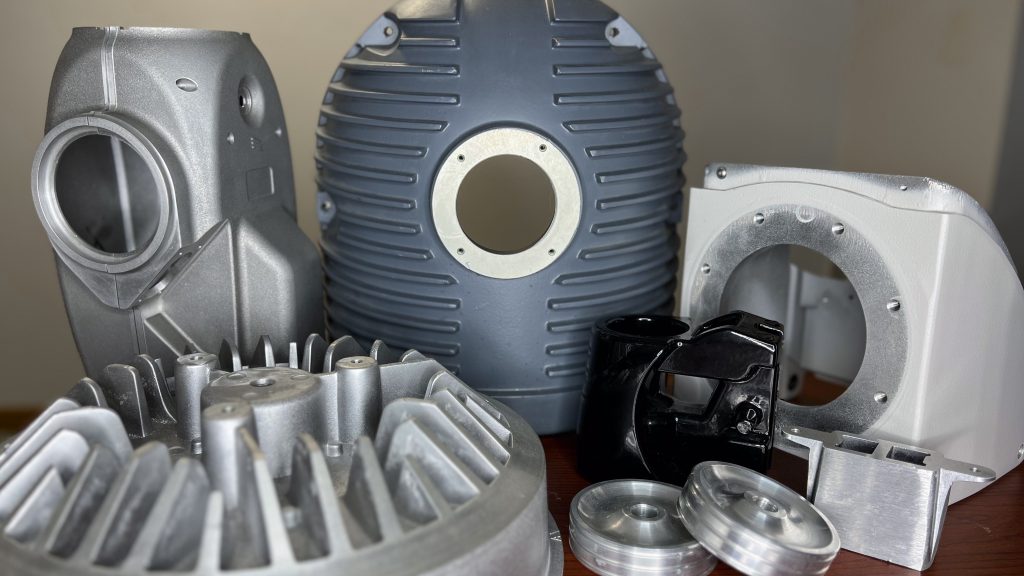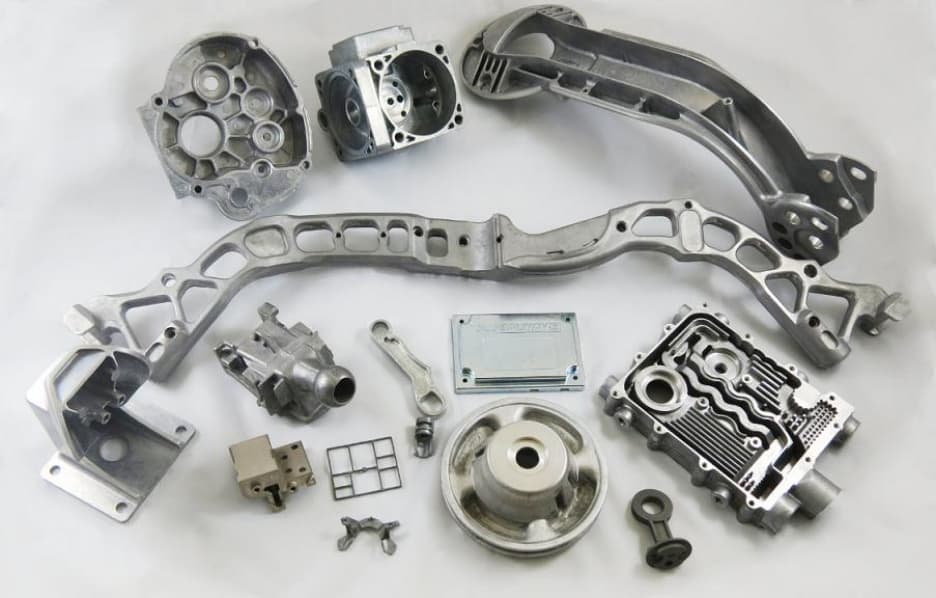Aluminum Castings and Metal Castings: a detailed look at their uses
Wiki Article
Exploring the Versatile Utilizes and Applications of Light Weight Aluminum Castings in Modern Industries
Aluminum castings have ended up being important to different modern-day markets as a result of their unique properties. They offer significant benefits in weight reduction, thermal conductivity, and corrosion resistance. From auto advancements to applications in customer items and building and construction, their convenience is amazing. Yet, real extent of their effect extends beyond prompt benefits, hinting at broader effects for sustainability and effectiveness. What exists ahead for aluminum spreadings in an ever-evolving commercial landscape?Automotive Market Innovations
The automobile market has significantly welcomed light weight aluminum castings to boost car efficiency and effectiveness. By utilizing aluminum, makers can generate lighter elements, which add to boosted gas economic situation and lowered discharges. Secret applications consist of engine blocks, transmission situations, and architectural components, where the material's strength-to-weight ratio delivers toughness without adding excess weight.Aluminum spreadings additionally provide premium thermal conductivity, which helps in much better heat dissipation, consequently enhancing engine performance. Developments in casting innovations, such as die spreading and sand casting, enable the production of intricate geometries, permitting for innovative designs that maximize room and functionality.
The recyclability of light weight aluminum straightens with sustainability objectives in the vehicle industry, promoting environmentally friendly methods. As the industry proceeds to introduce, using light weight aluminum castings is likely to broaden, driving additional innovations in vehicle layout and effectiveness.
Aerospace Developments and applications
While the aerospace sector remains to prioritize weight reduction and fuel performance, light weight aluminum castings have emerged as a vital product choice for different applications. Their light-weight nature, combined with high strength-to-weight proportions, allows for significant renovations in airplane performance and effectiveness. Light weight aluminum spreadings are frequently utilized in architectural elements, such as fuselage structures and wing components, where decreasing weight is important.Current developments in aluminum casting innovations, consisting of boosted alloy formulas and precision casting strategies, have actually better enhanced the product's efficiency capacities. These advancements enable the manufacturing of complex geometries and intricate layouts while keeping architectural stability. Additionally, aluminum's superb corrosion resistance warranties long life and dependability in rough aerospace atmospheres.
As the aerospace market increasingly accepts sustainability, aluminum spreadings supply a recyclable service that lines up with environment-friendly practices, making them a pivotal aspect in the advancement of next-generation aircraft.
Customer Goods and Everyday Products
As customers significantly look for light-weight yet durable materials for day-to-day items, aluminum castings have actually obtained popularity in various durable goods. The distinct properties of light weight aluminum, including its resistance to rust and superb thermal conductivity, make it an optimal option for things like cooking equipment, house appliances, and outdoor gear. Aluminum cast frying pans and pots offer even warmth circulation, improving cooking efficiency. Furthermore, using light weight aluminum in products such as bicycle frames and luggage assures an equilibrium in between stamina and portability. Producers value aluminum castings for their flexibility, as they can be easily built into complex shapes while maintaining structural integrity. The ability to recycle light weight aluminum without weakening its homes lines up with growing consumer preferences for sustainable items. Generally, light weight aluminum castings are essential to the production of long lasting, useful, and visually pleasing consumer products, satisfying the needs of modern way of lives.Construction and Architectural Makes Use Of
Aluminum spreadings have actually come to be an essential element in construction and building design, specifically as a result of their strength and lightweight nature. These residential or commercial properties make light weight aluminum an excellent selection for various applications, consisting of structural aspects, facades, and attractive attributes - Aluminum Foundry. Home builders and engineers significantly use light weight aluminum castings for window frameworks, doors, and roof, boosting both functionality and visual appeals. The product's resistance to corrosion further extends its life-span, reducing upkeep expenses and making certain toughness in varied ecological conditionsAluminum can be easily formed into complex layouts, enabling for innovative building expressions. Its flexibility facilitates the production of custom-made pieces that meet certain style demands, from elaborate barriers to intricate supports. As sustainability comes to be a priority, light weight aluminum's recyclability contributes to its appeal in green building and construction techniques. Generally, aluminum castings are reinventing the building sector by supplying light-weight, durable, and visually enticing options.
Digital and electrical Elements
Light weight aluminum castings play an essential duty in the production of light-weight electric units, which enhance transportability and efficiency in various applications. Furthermore, their excellent thermal conductivity makes them suitable for warmth sinks, guaranteeing peak performance and long life of electronic components. Light weight aluminum's conductive residential properties add to its use in numerous electric conductors, emphasizing its importance in contemporary innovation.Light-weight Electrical Units
Lightweight electrical enclosures play a crucial duty in safeguarding sensitive electronic parts from ecological elements and physical damage. Built from light weight aluminum castings, these enclosures are valued for their strength-to-weight proportion, making them ideal for various applications across industries. Their light-weight nature help in lowering total system weight, which is important in mobile and mobile electronic devices. Moreover, light weight aluminum's deterioration resistance boosts longevity, prolonging the life-span of the encased parts. The ability to mold aluminum right into intricate shapes enables customized designs, providing to details requirements while guaranteeing effective heat dissipation. In addition, these rooms can be quickly integrated right into existing systems, giving official site adaptability and versatility in modern-day technical atmospheres. In general, light-weight light weight aluminum enclosures considerably contribute to the effectiveness of electronic devices.Warm Sinks and Conductors
While several products are used in digital parts, light weight aluminum castings stand out for their efficiency in warm administration as heat sinks and conductors. Their excellent thermal conductivity permits effective warmth dissipation, which is crucial in avoiding the getting too hot of electronic gadgets. Aluminum's light-weight nature even more boosts its suitability for applications where weight is a substantial variable, such as in aerospace and automotive markets. In addition, light weight aluminum spreadings can be quickly built into intricate shapes, offering style flexibility for optimizing thermal efficiency. The deterioration resistance of light weight aluminum additionally contributes to the durability and dependability of these elements in various settings. As technology developments and gadgets come to be much more portable, the demand for efficient warm monitoring solutions, like aluminum castings, remains to expand.Marine Sector Application
The aquatic industry progressively counts on aluminum spreadings for their extraordinary durability and rust resistance. These homes make aluminum a perfect option for various applications, consisting of watercraft hulls, engine elements, and marine hardware. The lightweight nature of light weight aluminum spreadings enables boosted gas performance and much easier maneuverability in boat, which is vital for both recreational and commercial vessels.
Aluminum castings also give considerable cost advantages due to their long life-span and low upkeep needs, lowering the total operational expenditures for aquatic operators. Additionally, the convenience of light weight aluminum permits for intricate layouts that can meet particular efficiency demands.
Suppliers in the aquatic industry make use of advanced spreading strategies to create complex shapes, making sure that elements meet extensive safety and efficiency criteria. As the demand for high-performance aquatic vessels grows, aluminum spreadings are placed as an essential product in enhancing the performance and long life of marine tools.
Sustainability and Recycling in Aluminum Casting

Aluminum Recycling Process
Recycling light weight aluminum plays an important duty in lessening ecological influence and preserving resources within the casting sector. The light weight aluminum reusing procedure begins with the collection of scrap aluminum, which can include old parts, manufacturing waste, and post-consumer items. This scrap is then sorted, cleaned up, and shredded into little pieces to facilitate melting.When prepared, the aluminum scrap is melted in a furnace at lower temperatures than primary aluminum production, substantially reducing power consumption. The molten light weight aluminum is after that cast right into ingots or various other shapes for reuse in various applications - Aluminum Castings. This closed-loop system enables for the efficient healing of aluminum, protecting its properties while lowering the need for virgin products. The recycling process is a crucial component of sustainable techniques in aluminum casting.
Ecological Advantages
While light weight aluminum casting plays an important function in different sectors, its ecological advantages are specifically remarkable concerning sustainability and resource conservation. The light-weight nature of aluminum adds to energy efficiency in transport, decreasing fuel usage and exhausts. In addition, light weight aluminum spreading promotes using recycled products, substantially lowering the energy required for production contrasted to key light weight aluminum. This recycling procedure lessens waste and decreases the environmental effect related to mining and refining resources. Moreover, light weight aluminum is 100% recyclable without deterioration of its residential or commercial properties, promoting a lasting lifecycle. By picking light weight aluminum casting, industries can substantially lower their carbon footprint while promoting source effectiveness, making it an essential option in the pursuit of eco-friendly manufacturing methods.Closed-Loop Systems
Frequently Asked Concerns
What Are the Key Advantages of Aluminum Castings Over Various Other Materials?
Light weight aluminum castings supply light-weight buildings, exceptional corrosion resistance, and high strength-to-weight ratios. They can be conveniently built right into complex forms, provide good thermal and electric conductivity, and are affordable, making them preferable over lots of different products.How Is the Aluminum Spreading Refine Ecologically Pleasant?
The light weight aluminum spreading process is eco-friendly as a result of its recyclability, reduced power intake, and decreased waste production. Its capacity to utilize recycled materials lessens the carbon impact, advertising sustainability within manufacturing methods.What Prevail Difficulties in Aluminum Spreading Production?
Usual difficulties in light weight aluminum spreading visit this page production include maintaining dimensional accuracy, managing thermal tightening, protecting against problems like porosity and additions, guaranteeing proper mold and mildew style, and maximizing production effectiveness while reducing product waste and environmental influence.How Do Aluminum Castings Compare in Price With Various Other Production Techniques?
Aluminum spreadings usually offer competitive costs contrasted to other manufacturing techniques, particularly for medium to high-volume production. Their reduced preliminary tooling costs and efficient material usage can cause favorable business economics in time.What Future Patterns Are Anticipated in Aluminum Casting Modern Technology?
Future patterns in light weight aluminum casting innovation are expected to include advancements in automation, improved alloy compositions, improved reusing approaches, and the assimilation of 3D printing, all focused on increasing effectiveness, lowering prices, and decreasing ecological influence.Current innovations in aluminum casting modern technologies, consisting of enhanced alloy formulations and precision spreading strategies, have actually additionally enhanced the material's efficiency abilities. Aluminum castings have actually come to be an important component in building and construction and building design, especially due to their toughness and light-weight nature. The light weight aluminum recycling procedure begins with the collection of scrap aluminum, which can consist of old components, producing waste, and post-consumer items. When prepared, the aluminum scrap is melted in a heater at lower temperatures than main light weight aluminum manufacturing, greatly minimizing energy consumption. Furthermore, aluminum spreading assists in the use of recycled products, significantly decreasing the energy needed for production compared to key aluminum.
Report this wiki page